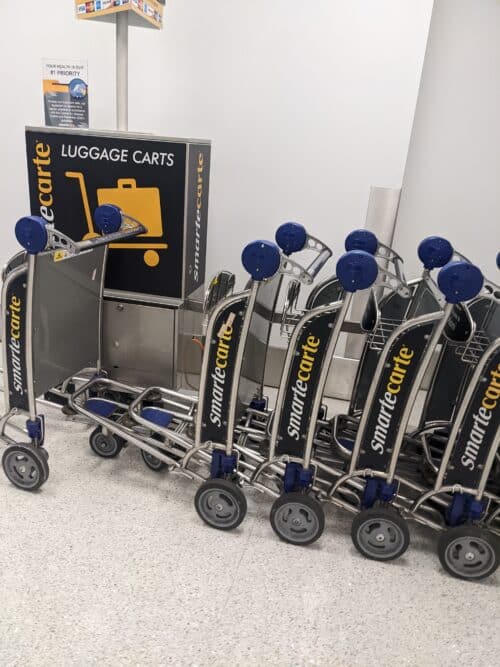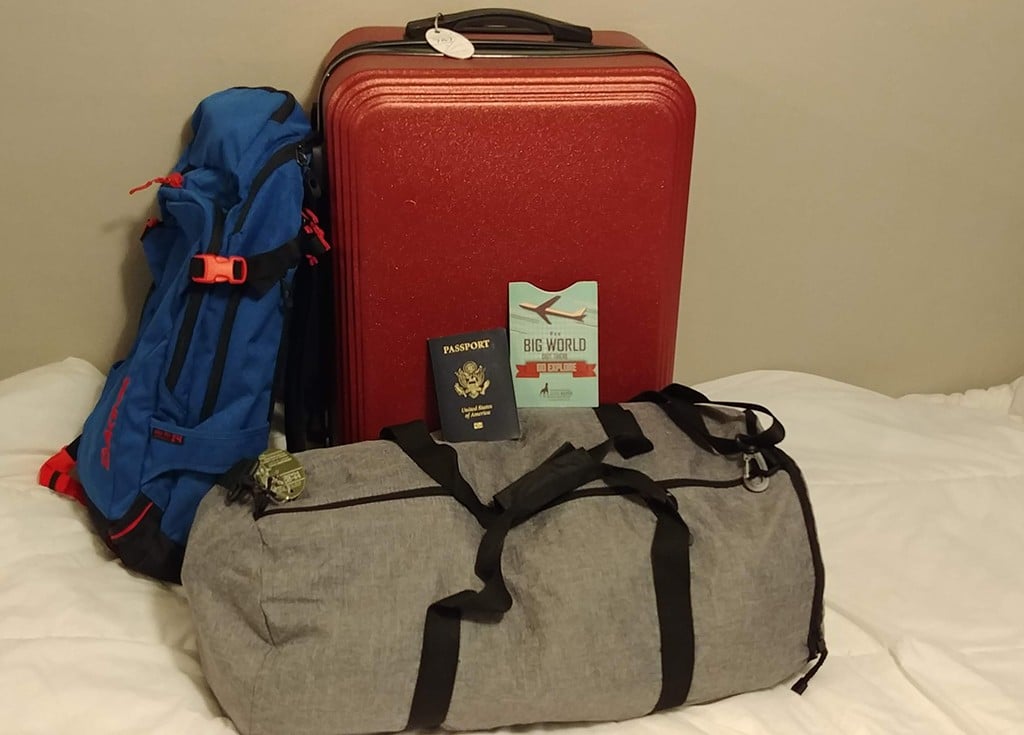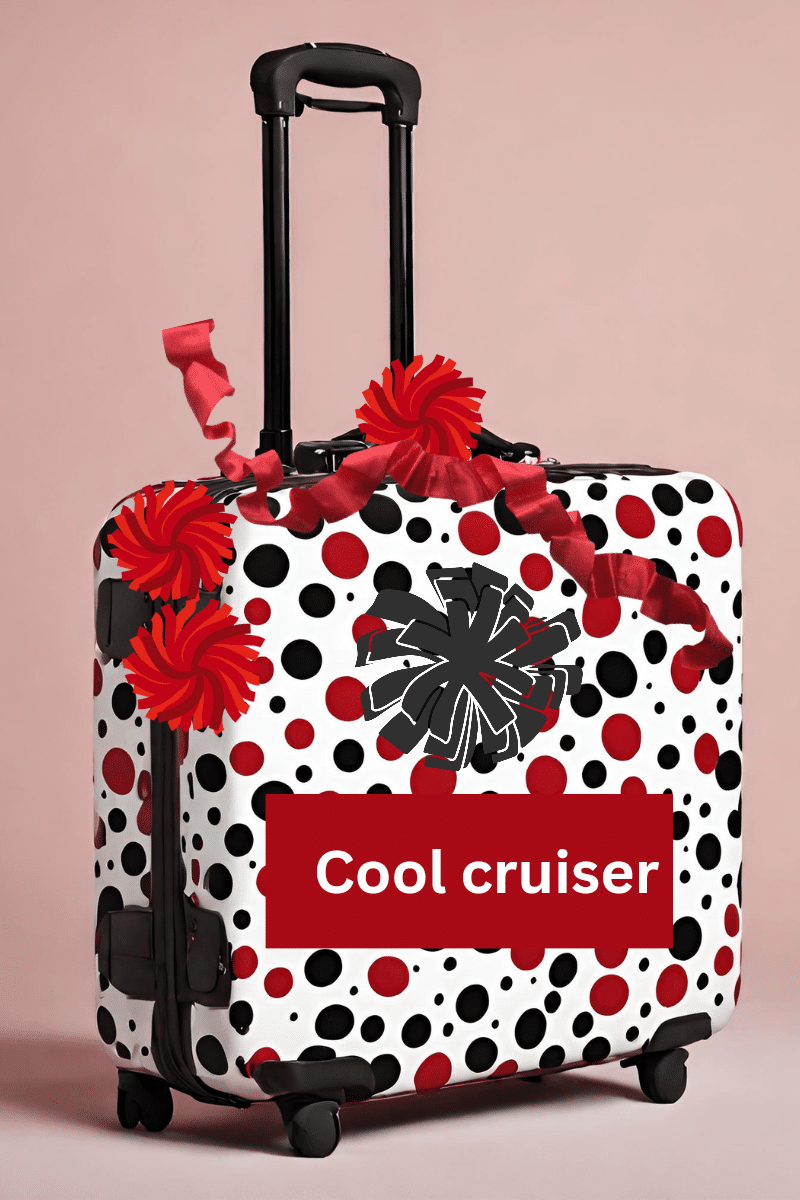Gallivanting Souls is reader-supported. When you buy through links on our site, we may earn an affiliate commission. As an Amazon Associate, I earn from qualifying purchases. Learn more.
Welcome aboard, fellow travelers! We know how exciting it is to embark on a new adventure, but mishandled baggage can put a damper on your journey.
That’s why we’re here to share some simple yet effective tips to keep your belongings right where they belong – with you!
First things first, if you can, travel with a carry-on only. This helps you stay in control of your belongings throughout your trip.
Travel insurance
Travel insurance will be your best investment if your bag is lost.
Find out about getting travel insurance
Understanding Mishandled Baggage: Numbers and Nuances
Before digging into travel hacks, let’s shed light on the “what” and “why” of mishandled baggage.
Mishandled in a Nutshell:
Mishandled baggage simply means any piece of passenger luggage that is lost, damaged, delayed, or misplaced during its journey. (Airport List. Net)
A Glimpse by the Numbers:
- Global Rate: In 2020, despite reduced air travel due to the pandemic, roughly 5.57 bags per 1,000 passengers encountered mishandling.
- Main Culprits: Errors in sorting, late check-ins, tight connections, and even airport disruptions can send bags astray.
- Fighting Back: Airlines and airports are deploying tech solutions like improved tracking systems and RFID tags, along with staff training, to tackle the issue.
- Regional Variations: Certain regions, with specific airport layouts, high passenger volumes, or even unpredictable weather, may face higher mishandling rates.
- Three Categories: Lost (vanished into thin air!), delayed (taking a later flight than you), and damaged (picked up worse for wear) are the three main types of mishandled luggage.
- Trend Watch: Pre-pandemic, the industry saw a decrease in mishandling thanks to technological advancements and process improvements.
These statistics highlight the prevalence of mishandled baggage and emphasize the importance of proactive measures to safeguard your belongings. Now, let’s equip you with practical strategies to keep your luggage on track!
Gallivanting Souls is reader-supported. When you buy through links on our site, we may earn an affiliate commission. As an Amazon Associate, I earn from qualifying purchases. Learn more.
Packing smartly
When it comes to packing, durability matters. You never know if your case is going to fall off the baggage cart.
Choose sturdy luggage that can handle the journey like this Level8 Luminous 24″ check-in bag. For tips on picking the right one, check out experts at Consumer Reports.
Packing cubes
Packing cubes are your secret weapon. They keep your items organized and save space.
Get quality ones to make packing a breeze. You can find them at most travel stores or online marketplaces.
Cross pack
Now, here’s a nifty trick – cross-packing. Spread your essentials across different bags.
This way, if one bag goes on its own adventure, you’ll still have what you need.
Trust us, it’s a game-changer.
And don’t forget to pack an entire change of clothes and your must-have toiletries in your carry-on.
It’s a lifesaver if your checked baggage decides to take a detour.

Video: How to make your luggage stand out
Foolproof way to ensure luggage safety
The only way to guarantee your bagage is not damaged, delayed, or lost is to carry it with you. Not check your bag.

Tag It Right: Secrets to Luggage Labels That Actually Work
Say goodbye to the black suitcase shuffle! Clear and accurate luggage tags are your best friends, ensuring your precious cargo gets to the right destination (and back!). Here’s how to make them work for you:
Fill ‘Em Up with Essentials:
- Your Name & Contact Info: This might seem obvious, but double-check for typos! Include either your email address or mobile phone number (with international code). Choose the method you check most frequently.
- Inside Scoop: Tuck a duplicate contact card inside your luggage for an extra layer of security. Bonus points for a printed itinerary if you have one!
Label Like a Pro:
- Destination Decoder: When checking in, verify your bag is tagged with the correct final city code, not just the name. A quick Google search is your friend. (Fun fact: Spokane, WA’s code is GEG!)
- No Smudges Allowed: Ensure the label is clearly printed and legible. A blurry scribble can lead to unintended detours for your suitcase!
Don’t Ditch the Stubs:
Hold onto those luggage receipts like precious travel souvenirs (just kidding, but they’re pretty valuable!). Here’s why:
- Proof of Ownership: Need to prove you packed that sparkly dress? The receipt is your evidence!
- Lost & Found Helpers: If your luggage goes AWOL, the receipt details like tag numbers are crucial for filing a claim and reuniting with your belongings.
- Insurance Ace: Lost or damaged items? Travel insurance might reimburse you, but the receipt is your key to unlocking that sweet compensation.
- Customs Clarity: Flying internationally? Customs officials might request proof of ownership for certain goods. Your trusty receipt comes to the rescue!
- Digital Detective: Some airlines offer digital baggage tracking linked to your receipt or app. Ditch the paper and embrace tech if you’re a digital nomad!
- Double-check Contents: If your bag contents seem to have mysteriously rearranged, the receipt can help settle the score.
-
- Reimbursement Rescue: Need to buy essentials due to delayed luggage? The receipt becomes your evidence for reimbursement from the airline.
Remember:
So, hang onto those stubs like they hold your travel sanity! Keep them safe alongside your passport and boarding pass. Remember, a little prep with labels and stubs can save you big headaches and ensure your luggage travels as smoothly as you do.
Bonus Tip:
Stand out from the sea of black suitcases! Add a vibrant luggage strap or a brightly colored ribbon to your bag. It’ll make your luggage easier to spot on the carousel, plus it adds a touch of personality!
Now, with your luggage prepped and ready, you’re all set to conquer the world (or at least your next vacation)!
Video: Why don’t airport codes match their names?
Mastering the Luggage Tag: What to Write (and What to Skip)
Composing the perfect luggage tag is like writing a haiku—every word counts! Here’s how to create a masterpiece that reunites you with your belongings:
Privacy First:
- Home Sweet Home, Off the Record: Keep your home address under wraps. Opt for your home airport code as a discreet identifier.
Contact Clarity:
- Phone Number Priority: Include your phone number, ensuring it’s the one you check most often.
- Email Optional: Add your email address only if you’re known for prompt responses. Remember, no one wants to play email tag with a delayed suitcase!
Name Game:
- Strike a Balance: Use your first initial and last name for a combo of privacy and recognition. Think “J. Smith” instead of “Jane Smith” or “Homeowner at 123 Main Street.“
Legible Lines:
- Channel Your Inner Calligrapher: If handwriting, unleash your neatest penmanship. Think “Block letters”. A smudged name could send your luggage on an unintended adventure!
Business Card Hack:
- Savvy Traveler’s Shortcut: Got a business card? Stick it on and add the city code for an effortless solution!
Luggage Tag Bonus Tip:
Laminate your tag or use a waterproof cover to safeguard it against spills or weather surprises. A little protection goes a long way!
Remember:
- Double-check your contact details for accuracy. Typos can lead to a frustrating game of hide-and-seek with your luggage!
- Consider having a duplicate tag inside your luggage for extra security.
- Regularly update your information if you change phone numbers or email addresses.
By following these tips, you’ll create luggage tags that not only look professional but also effectively protect your privacy and ensure a smooth travel experience.

Visual Security: Snap Proof of Your Packed Paradise
For ultimate peace of mind on your travels, consider adding a little photo magic to your packing routine. Here’s how:
Step 1: Picture Perfect Packing: Before zipping up your suitcase, take a quick photo of its contents. This visual inventory becomes your security blanket, offering:
- Proof positive: Got that new camera lens in there? Need to double-check for souvenirs before a customs check? Your photo provides instant evidence.
- Missing item detective: Can’t remember if you packed that blue swimsuit? A quick glance at your photo solves the mystery and saves unnecessary unpacking panic.
- Damage documentation: In case of unfortunate baggage encounters (bumps, spills, or worse!), having a documented starting point for your belongings’ condition can be invaluable.
Bonus Tip:
- Get detailed: Take close-up photos of valuables like jewelry or electronics for extra protection.
- Go digital: Consider utilizing apps designed specifically for luggage inventory management. Some even sync with cloud storage for secure access anywhere.
Remember, these photographic proof points offer peace of mind and valuable documentation in case of any luggage-related hiccups. So, snap away, and enjoy your adventures knowing your belongings are visually accounted for!

Step 2: Capture the Exterior:
Once your suitcase is zipped and ready to roll, snap a shot of its outer shell. This simple step becomes your luggage’s personal paparazzi moment, granting you the power of:
- Instant Recognition: No more squinting at identical black suitcases on the carousel! Your photo lets you spot your travel companion in a flash.
- Lost and Found Hero: Should your luggage embark on an unscheduled adventure, its unique portrait becomes a crucial identification tool for both you and airline personnel.
- Packing Peace of Mind: Before rushing out the door, a quick peek at your photo confirms you haven’t left your favorite travel essential (read: passport!) behind.
So, remember:
- Capture the full suitcase from different angles to showcase any distinct features.
- Include any personalized accessories like luggage tags or stickers for extra identification power.
- Consider storing your photos in a cloud storage platform for easy access anywhere.
By combining these photo steps, you create a visual security blanket for your belongings, ensuring a smoother and more secure travel experience. Happy packing, happy snapping, and happy travels!

Making Your Bag Stand Out
In a sea of black bags on the luggage carousel, it’s crucial to make your bag easy to spot.
Here are some tips to help you make your luggage unique:
1. Colorful Luggage Tags: Attach bright and distinctive luggage tags to your bag.
These not only add a pop of color but also make your bag easily recognizable.
2. Unique Stickers or Decals: Apply unique stickers or decals to your luggage.
These can be fun, quirky, or personalized to reflect your style.
As a Sea Hawks fan, our navy blue case is decorated in neon green duck tape stripes.
3. Custom Luggage Straps: Consider using custom luggage straps with bold patterns or vibrant colors.
These not only secure your bag but also make it stand out in a crowd.
4. Distinctive Luggage Covers: Invest in a distinctive luggage cover or sleeve.
This not only protects your bag but also makes it instantly recognizable.
You can choose from many designs like these Travelkin luggage covers on Amazon, or create your own custom design like at Ceosande on Amazon.
5. Tie a Bright Ribbon or Band: Tie a bright ribbon or band around your luggage handle.
This simple addition can make a big difference in identifying your bag.
6. Personalized Luggage Tags: Opt for personalized luggage tags with your name and contact details.
This not only adds a personal touch but also helps in case your bag is misplaced.
These can as simple as taking your business card and laminating to ordering a customized one from Amazon or Etsy.
7. Unique Bag Design: Choose a bag with a distinctive design or pattern.
This way, even without additional identifiers, your bag will stand out.
Did you know that the most common way a bag goes missing is because someone else mistook it for their own?
By taking these simple steps, you’ll make your bag unmistakable, saving you time and ensuring you leave the airport with the right luggage in tow.
Lost Luggage Lessons Learned: A Miami Mishap and Cross-Packing Magic
Miami sunshine, Panama Canal dreams… then BAM! My husband Mike’s suitcase decided to go rogue, leaving us with two days of travel and zero essentials. Talk about a travel nightmare!
We dutifully filed a claim, clung to hope, and learned a crucial lesson the hard way: the magic of cross-packing. Yep, Mike’s wardrobe was chilling in Hawaii while we were sweltering in Miami – all because everything except two outfits was hostage in that missing bag.
The airline’s advice? Emergency shopping for clothes and toiletries. Thankfully, just as our cruise ship was about to cast off, the prodigal suitcase returned. A close call, but a valuable experience that sent us rushing to change our packing habits.
Enter cross-packing, our new travel bestie: distributing essentials across all our bags. Now, Mike’s carry-on isn’t just for last-minute snacks; it’s a mini wardrobe and hygiene haven. We’ve learned to pack smart, ensuring both of us have enough in our carry-ons to survive any luggage detour.
So, dear travelers, heed our Miami misadventure! Embrace the cross-pack, spread the essentials, and say goodbye to luggage-induced panic. Because when it comes to travel, preparedness is the name of the game, and that missing suitcase in Hawaii? Well, it just became a hilarious (and cautionary) travel tale!
Tracking Your Suitcase: Become a Proactive Traveler
-
Put Your Airline’s App to Work: Download your airline or cruise line’s app and unlock a personal travel assistant—right in your pocket! Many apps offer real-time baggage updates, keeping you informed of your belongings’ whereabouts throughout your journey.
-
Embrace the Power of Tracking Devices: Consider adding a luggage tracking device to your travel arsenal. These innovative gadgets can be lifesavers if your luggage decides to take an unexpected detour.
Options for Android Users:
- Tile Pro: Known for its long-range and loud alarm, The Tile Pro is a reliable choice for keeping tabs on your luggage.
- Samsung SmartThings Tracker: Leverage the power of Samsung’s SmartThings ecosystem with this versatile tracker.
- Chipolo ONE: Enjoy a sleek and compact design with Chipolo ONE, offering a strong Bluetooth range for effective tracking.
For Apple Users:
- AirTag: Tap into the seamless integration of Apple’s Find My network with AirTags. These Bluetooth-enabled trackers help you locate your belongings with ease, even within a busy airport.
Peace of Mind, Personalized:
By embracing these technologies, you not only make your bag stand out in a crowd, but you also add a valuable layer of security to your belongings. Take control of your luggage tracking and enjoy the peace of mind that comes with knowing where your precious cargo is at all times.
Additional Tips:
- Remember to activate and test your tracking device before your trip to ensure it’s working properly.
- Consider placing a tracker inside your luggage as well as on the outside for added security.
- Check for compatibility with your phone’s operating system and any necessary apps.
- If you’re traveling internationally, research any restrictions on using certain tracking devices.
- Looking for more in-depth reviews and comparisons of luggage tracking devices? Stay tuned for my upcoming article where I’ll dive deeper into the features, pros and cons, and help you choose the perfect tracker for your travel style!
RFID tracking tags
There are RFID (Radio-Frequency Identification) tags available specifically designed for luggage. These tags incorporate RFID technology to help track and identify luggage during travel. They work by transmitting a unique identifier that can be read by RFID scanners.
RFID luggage tags offer several advantages:
1. Enhanced Tracking: RFID tags can provide real-time tracking information, allowing travelers and airlines to monitor the location of luggage throughout its journey.
2. Reduced Mishandling Risk: With accurate tracking, the risk of luggage being mishandled, lost, or misplaced is reduced, leading to a smoother travel experience.
3. Quick Identification: RFID technology enables quicker identification of luggage, especially in busy airports or during baggage handling processes.
4. Convenience: Some RFID tags can be registered with travel apps, allowing travelers to receive notifications and updates about their luggage on their smartphones.
5. Improved Security: RFID technology can help prevent unauthorized access to your luggage, providing an extra layer of security.
Understood! Here’s an edit without focusing on airline or service provider compatibility:
Taking Control: Choose the Right RFID Tag for Bag Tracking
While relying on airlines for luggage tracking is common, sometimes extra peace of mind comes from taking matters into your own hands. Enter the world of RFID tags, and personal tracking beacons for your beloved bags! But before you attach one and go, choosing the right tag is key. Here’s how:
1. Phone Friendly: Do you envision tracking your bag on your phone via an app? Then pick a tag that seamlessly pairs with your device’s operating system (iOS or Android) and any tracking apps you plan to use.
2. Size and Toughness: Consider your luggage size and choose a tag that doesn’t add unnecessary bulk. Durability is essential, so look for waterproof and shockproof features to withstand travel bumps and tumbles.
3. Signal Strength: Opt for a tag with a strong signal range to maximize detection within airports and beyond. This can help during layovers or if your bag takes a detour.
4. Readability Matters: Choose a tag with clear identification details like your contact information, making it easier for someone to return your bag if it gets separated.
5. Consider Extras: Some tags offer additional features like built-in scales, temperature sensors, or even proximity alerts. Decide what extras fit your needs and travel style.
By taking these steps, you can choose an independent RFID tag that puts you in control of your luggage tracking, offering additional peace of mind wherever your travels take you.
Remember, while airline systems may not always be foolproof, using a personal RFID tag empowers you to take a proactive approach to keeping your luggage safe and monitored.
Don’t forget Insurance
Travel insurance is important when it comes to baggage because it provides a safety net in case your luggage is lost, delayed, or damaged during your journey.
Here are some key reasons why travel insurance with baggage coverage is valuable:
1. Compensation for Lost Baggage: If your luggage is permanently lost by the airline or cruise line, travel insurance can provide compensation for the value of your belongings, up to the policy limit.
2. Coverage for Delayed Baggage: If your luggage is delayed for an extended period (usually 12 to 24 hours), travel insurance can cover the cost of essential items like clothing, toiletries, and other necessities until your baggage is returned to you.
3. Reimbursement for Damaged Items: If your belongings are damaged during transit, travel insurance can provide reimbursement for the repair or replacement of those items, up to the policy limit.
4. Additional Coverage for High-Value Items: Some travel insurance policies offer additional coverage for high-value items like electronics, jewelry, or sporting equipment, which may not be fully covered under a standard policy. Heads up: these items need to be declared when checking your bag.
5. Peace of Mind and Reduced Stress: Knowing that you have insurance coverage for your baggage can offer peace of mind during your trip.
It reduces the stress and inconvenience of dealing with lost or damaged luggage.
6. Coverage for Personal Liability: In rare cases, if your baggage causes damage or injury to others, travel insurance may provide coverage for personal liability claims.
7. Assistance with Baggage Retrieval: Travel insurance providers often have resources and contacts to help you locate and retrieve lost or delayed baggage more efficiently.
Remember to carefully review the terms and conditions of your travel insurance policy, especially the sections related to baggage coverage, to understand what is and isn’t covered.
Additionally, keep all receipts and documentation related to your baggage and any expenses you incur due to mishandling, as these may be required when filing a claim.
You may already have some travel insurance benefits. Check the credit card you booked your trip through.
Often credit cards offer minimal coverage, but stand-alone trip insurance is always best.
Baggage no shows
Stay calm. It happens to the best of us. If you find that your luggage is lost, delayed, or damaged, follow these steps:
- Report the Issue: Immediately contact the airline or cruise line’s lost baggage department. This is crucial! Do not leave the airport or cruise terminal before reporting the problem.
- Provide Details: Be ready to provide your flight or cruise information, luggage tag details, and a description of your bag. The more information you provide, the faster they can assist you.
- Get a File Reference Number: Make sure to ask for a file reference number or case number. This will be important for tracking the progress of your claim.
- Ask for Compensation Details: If your bag is delayed, ask about any compensation or reimbursement for essential items you may need in the meantime.
- Keep Records: Document all interactions and communications regarding your lost baggage. This includes names, dates, and any promises made.
Remember, reporting the issue promptly is crucial.
Do not leave the airport or cruise terminal without reporting it.
This ensures that the process of locating your baggage starts as soon as possible.
Bon Voyage, Baggage Blues!
So, there you have it, travelers! From labeling tricks to luggage photography, these simple steps can transform you from baggage victim to packing pro. Remember, a little proactive planning translates to a lot less travel stress.
Let’s recap your travel toolkit:
- Label like a boss: Clear tags, accurate information, and maybe a pop of color for easy spotting.
- Keep those stubs: Your receipts are luggage lifesavers, offering proof of ownership and aiding in lost baggage claims.
- Fill ’em up with essentials: Contact details, inside identification, and even a printed itinerary – think like a luggage detective!
- Snap proof of your paradise: Visual inventories of both contents and exterior are your friends for verification, insurance, and peace of mind.
- Embrace the cross-pack: Spread the essentials across your bags, so a missing suitcase doesn’t mean a wardrobe meltdown.
With these tips tucked away, you’re empowered to navigate the world with confidence, knowing your precious cargo is prepped and protected. So, go forth, explore, and embrace the adventure – your luggage is ready to follow!
- Want to conquer packing like a seasoned traveler? My checklist is your secret weapon: Link to download
Safe travels, happy packing, and remember, a little preparation goes a long way!
Video: What airlines don’t want you to know
https://youtube.com/shorts/eirIaGwE0-s?si=vDkgyJzctVvmAGTY
Baggage Terms to know
- Mishandled
- Lost
- Damaged
“Mishandled” baggage refers to luggage that has been improperly handled during transportation.
This can include situations where luggage is delayed, damaged, or misplaced temporarily.
Airlines typically classify baggage as mishandled if it’s not delivered to the passenger on time or if it’s damaged upon arrival.
“Lost” baggage, on the other hand, refers to luggage that cannot be located and returned to the passenger within a specific time frame (usually after an extensive search).
In such cases, the airline may consider the baggage as permanently lost.
This typically occurs when the baggage tag is damaged, lost, or the information is unclear, making it impossible to track and reunite with the owner.
In summary, mishandled baggage is a broader term that encompasses various issues related to luggage handling, including delays and damages, whereas lost baggage specifically refers to luggage that cannot be located or returned to its owner.
Video: Apple Air Tag Review. How to track your holiday luggage effortlessly.
FAQ’s about luggage tags and identification
1. Why is it recommended to use my home airport code instead of my home address on luggage tags?
– A: Using your home airport code provides a level of privacy and security.
It identifies your general location without revealing specific residential details.
2. Should I include both my phone number and email on the luggage tag?
– A: Including both contact methods is a good practice, as it ensures that you can be reached in different situations or preferences of the finder.
3. Why use my first initial and last name for identification?
– A: This approach strikes a balance between privacy and identification.
It gives enough information for recognition without revealing your full name.
4. What if my handwriting isn’t very neat?
– A: If you’re concerned about legibility, consider using a label maker or printing out your contact information for clear and easily readable identification.
5. Can I use a business card as my luggage tag?
– A: Yes, using a business card can be a convenient option.
You only need to add the city code for further identification, making it a simple yet effective choice.
FAQs covering mishandled baggage, prevention Resolution
1. What is considered mishandled baggage?
– A: Mishandled baggage includes luggage that is lost, delayed, damaged, or otherwise improperly handled during transportation.
2. How can I prevent mishandled baggage during my travels?
– A: To prevent mishandled baggage, consider using unique identifiers, cross-packing essentials in your carry-on, and investing in a reliable luggage tracker.
3. What should I do if I suspect my luggage has been mishandled?
– A: Immediately report the issue to the airline or cruise line’s lost baggage department.
Do not leave the airport or cruise terminal without reporting the problem.
4. How can I track the progress of my lost or delayed baggage claim?
– A: Use the file reference number provided by the airline or cruise line to check the status of your claim through their official channels.
5. What steps should I take if my luggage is lost or delayed?
– A: Report the issue, provide necessary details, and ask for a file reference number. Additionally, inquire about compensation for essential items if your bag is delayed.
6. How can I file a complaint about mishandled baggage or customer service?**
– A: Contact the customer service department of the airline or cruise line.
You can usually find their contact information on their official website or on your booking documents.
In the United States, passengers can file complaints about airline service issues, including mishandled baggage, with the Department of Transportation (DOT).
The DOT has a dedicated Aviation Consumer Protection Division that handles such complaints.
For travelers in the U.S., the contact information is as follows:
Department of Transportation Aviation Consumer Protection Division:
–Phone Number: 1-202-366-2220 (Mon-Fri, 9am-5pm ET)
– Online Complaint Form: by [DOT Aviation Consumer Protection Division Complaint Form](https://www.transportation.gov/airconsumer/file-consumer-complaint)
7. Is travel insurance helpful in cases of mishandled baggage?
– A: Yes, travel insurance can provide coverage for lost, delayed, or damaged luggage. Contact your insurance provider and follow their instructions for filing a claim.
8. Can I track my lost luggage with a tracker like an AirTag or similar device?
– A: Yes, devices like AirTags can be used to help locate lost luggage. They work with compatible smartphones to provide real-time tracking information.
7. Is travel insurance helpful in cases of mishandled baggage?
– A: Yes, travel insurance can provide coverage for lost, delayed, or damaged luggage.
Contact your insurance provider and follow their instructions for filing a claim.
8. Can I track my lost luggage with a tracker like an AirTag or similar device?
– A: Yes, devices like AirTags can be used to help locate lost luggage.
They work with compatible smartphones to provide real-time tracking information.

Prepared
Now that you’re prepared and know what to do in case of mishandled baggage, where will you go? Contact us today to start planning!
At Gallivantingsouls.com we share our knowledge about cruising & travel. We are here to help you enjoy the journey!
Follow us on Social Media

Disclaimer:
Gallivanting Souls is reader-supported. When you buy through links on our site, we may earn an affiliate commission. Learn more.


